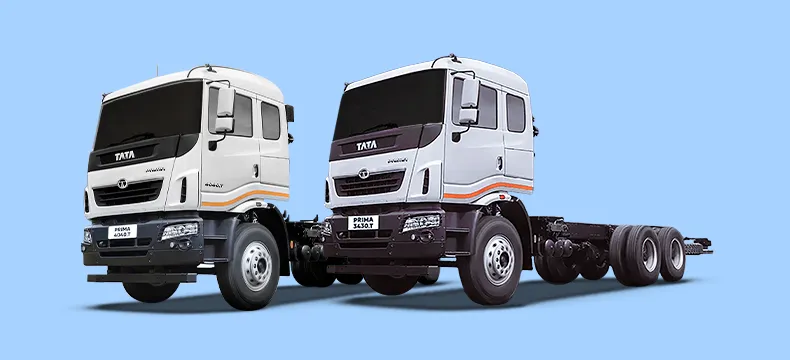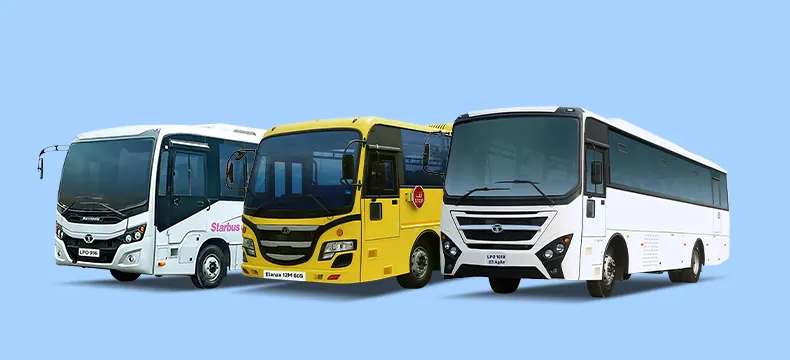5 Dec 2025

Coach vs. Bus: What's the Difference Between Them?
- Tata Motors
- 16 May 2025
- COMMERCIAL VEHICLE
Introduction
Whether you are planning to rent or buy a vehicle for group transportation in the Middle East, you will come across options like coaches and buses. Both vehicle categories service the same primary function. They move multiple passengers cost-effectively. However, their design, comfort level, and purpose vary significantly. Read on to understand the fundamental differences between a coach and a bus to make the right selection for your travel needs.
Coach vs. Bus – Overview
A bus is an everyday mode of transportation specifically designed for short-distance travel within cities. These vehicles operate on predetermined routes with frequent stops. They are an essential part of the public transit system. A standard bus will have efficiency, affordability, and accessibility as the prioritised features over comfort.
A commercial coach is a type of bus built for long-distance travel. It offers superior comfort and amenities than a standard bus. Coaches also include special features such as air conditioning, reclining seats/sleeper booths, onboard entertainment, and spacious luggage storage. This makes them comfortable for extended travel.
Coach vs. Bus Comparison: Understanding Key Differences
The main points of difference between a coach and a bus are explained as follows:
-
Purpose and Usage
Buses are primarily used for public transportation within cities. They follow fixed routes with frequent stops. This makes them ideal for daily commutes, school transport, and urban mobility.
A coach is designed for long-distance travel with a limited number of stops. Coaches are commonly used for private group travel, airport transfers, and business excursions where comfort for long hours is a priority.
-
Comfort Amenities
As discussed earlier, buses prioritise efficiency over comfort. Most city buses have upright seating in a desk-like arrangement with limited legroom, no onboard entertainment, and little to no space for luggage.
Coaches are equipped with premium features, including reclining/sleeper seats with ample legroom, air conditioning, and entertainment systems. Some high-end coaches also include restrooms, Wi-Fi, charging ports, and refreshments.
-
Capacity
City buses accommodate both seated and standing passengers. They have multiple doors for quick entry and exit for smooth passenger flow.
Coaches focus on passenger comfort. Thus, they mostly come with seated accommodations. The seating arrangement includes armrests, footrests, and spacious aisles. Additionally, coaches have luggage compartments.
-
Operational Flexibility
A standard bus operates on a predefined schedule and route, with little room for customisation. The public transport authorities regulate bus services for maximum efficiency.
A coach offers more flexibility in scheduling and changing routes. This allows travellers to book private charters for customised journeys.
-
Cost Considerations
Buses are more affordable due to high passenger capacity and lower operational costs. For passengers, public bus fares are subsidised in many regions across the Middle East. This makes buses a budget-friendly choice.
Coaches are generally more expensive due to added comfort and private booking options. The exact cost depends on factors like travel distance, rental duration, and amenities.
When to Choose a Coach vs. a Bus?
Selecting between a coach and a bus depends on your travel needs. Here are some points to help you decide:
Choose a Bus if:
- The journey is within the city or the metropolitan area.
- You need a cost-effective solution for frequent, short-distance travel.
- You prioritise accessibility and efficiency over comfort for the passengers.
Choose a Coach if:
- The travel involves covering long distances between cities.
- You deem passenger comfort, luggage space, and additional amenities as important.
- You are seeking a private vehicle for a long tour, business trip, or commuting passengers for special events.
Conclusion
The main points of coach vs. bus comparison are based on the intended use, design, and comfort levels. Coaches and buses are both forms of public transportation that serve different purposes. Buses mainly cater to urban commuters, while coaches offer a premium experience for long-distance travellers. When choosing between the two, assessing your journey needs, prioritising efficiency vs. luxury, and fine-tuning cost considerations will help.
FAQs
Do coaches have more safety features than buses?
Yes, coaches often have better safety features like seatbelts, reinforced structures, and advanced braking systems. Also, coaches have elevated seating, which leads to less impact of the vibrations. However, city buses also follow strict safety standards, focusing on accident prevention in urban environments.
Which is more fuel-efficient, a coach or a bus?
Buses are generally more fuel-efficient for short city routes due to frequent stops and lower speeds. Coaches can use more fuel as they are designed for long-distance travel but can optimise efficiency over highways.
Why do coaches cost more than a bus?
Coaches are more expensive because they offer extra comfort, amenities, and personalisation options. On the other hand, buses are designed for public transport with minimal amenities, which keeps the costs lower. They have a basic setup that meets the criteria of seating arrangement and accommodating as many passengers as possible.
- Tags
Latest Blogs


4 Dec 2025
Tanker Trucks: Types, Capacity, and Safety

4 Dec 2025


















